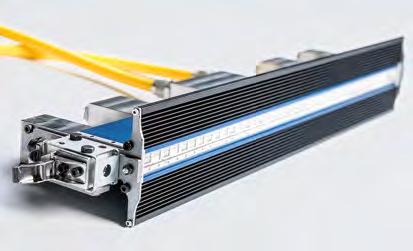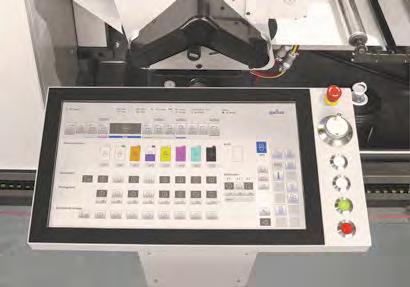
12 minute read
Gallus Labelfire impresses with its exceptional stability during continuous operation
La luce UV che emerge dalla striscia al centro del modulo di pinning (pre-fissaggio) serve a fissare le gocce d’inchiostro / UV light emerges from the strip in the centre of the pinning module to fix the ink droplets (Source: Gallus Ferd. Rüesch AG).
una media di 35.000 metri al giorno, alcuni utilizzatori raggiungono una prestazione media di 175.000 metri in una settimana di 5 giorni lavorativi. Produzioni settimanali ancora più elevate vengono segnalate da quegli stampatori che lavorano con Labelfire 24 ore su 24, ad esempio nei siti di produzione Philip Morris. Nella stampa degli astucci pieghevoli si raggiungono velocità di tiratura di oltre 300.000 metri/settimana. Con questa elevata produttività, vengono utilizzati fino a 8.000 litri di inchiostro digitale/inkjet per macchina da stampa all’anno. Le prestazioni del sistema di stampa ibrida si riflettono anche su un consumo di inchiostro così importante.
Advertisement
QUALI ACCORGIMENTI TECNOLOGICI HANNO PORTATO ALL’AUMENTO DELLA STABILITÀ?
“Il controllo di nuova concezione delle testine di stampa che Gallus ha incorporato nello sviluppo dell’unità di stampa digitale, è un fattore chiave che contribuisce a una qualità di stampa più stabile ad alta velocità”, dice Martin Leonhard, responsabile dello sviluppo aziendale di Gallus Ferd. Rüesch AG. Il collega Uwe Alexander, Digital Product Manager aggiunge: “oltre a questa tecnologia migliorata della testina di stampa, Labelfire è dotata di una gamma di funzioni di controllo coordinate che la qualificano per l’uso industriale 24/5 o 24 ore su 24, 7 giorni su 7”. Ora che le macchine sul mercato hanno implementato questi aggiornamenti, il successo dei miglioramenti è confermato dal feedback positivo. “La forza di Labelfire è la sua produttività”, conferma Valentina Pasqui di Pasqui srl, uno degli utilizzatori più produttivi in Italia. Questo è dimostrato dai dati relativi alle prestazioni di tiratura, che mostrano uno sviluppo impressionante.
ENGLISH Version Gallus Labelfire impresses with its exceptional stability during continuous operation
THE INDUSTRIAL CONDITIONS THAT HIGH-PERFORMANCE USERS IMPOSE ON THEIR DIGITAL PRINTING SYSTEMS, PLACES EXTREMELY HIGH DEMANDS ON THEIR PRESSES. THE GALLUS LABELFIRE HAS BEEN EQUIPPED WITH SPECIAL FEATURES TO MEET THESE CHALLENGES. AS A RESULT, IT DELIVERS A LEVEL OF PRODUCTIVITY IN CONTINUOUS OPERATION THAT WAS PREVIOUSLY UNHEARD OF IN INKJET PRINTING SYSTEMS
The Gallus Labelfire is the most widely used hybrid printing system on the market today. Serial number 50 went into production in spring 2020 and it is used for both label and folding box printing. At the core of the Labelfire system is a UV inkjet digital printing unit with 7 colours plus white, which is supplemented by five flexographic printing units for varnish application, metallic and special colours and also for cold foil adhesive application. A rotary die-cutting unit allows finishing at full press speed. Since the launch of the Labelfire in 2016, a lot has changed in the market segment for hybrid machine systems. It transpires that it is precisely the requirements of high-performance users that give the impetus for the further development of machine systems. It is characteristic of such printers to use monitoring systems to specifically record the productivity of their machine systems via KPIs. If deviations from the standard occur, this starts the process to eliminate the causes, together with the machine manufacturer and other system participants, or to define goals that one wants to achieve.
IMPRESSIVE MILEAGE WITH HIGH PERFORMANCE USERS Gallus defines high-performance users as companies that operate the Labelfire in three shifts and achieve an average daily output of 30,000 to 50,000 running metres. With an average of 35,000 metres per day, top users achieve an average performance of 175,000 metres in a 5-day week. Even higher weekly outputs are reported by “frontrunners”, businesses who work the Labelfire 24/7, for example at Philip Morris production sites. In folding carton printing, run rates of over 300,000 metres/week are achieved. With this high productivity, up to 8,000 litres of digital/inkjet ink are printed per press per year. The performance of the hybrid press system is also reflected in the ink consumption of this magnitude.
WHAT CHANGES LED TO THE INCREASE IN STABILITY? “The newly developed control of the print heads that Gallus has incorporated into the development of the digital printing unit, is a key contributing factor towards more stable print quality at high speed,” says Martin Leonhard, Head of Business Development at Gallus Ferd. Rüesch AG. Colleague Uwe Alexander, Digital Product Manager adds, “In addition to this improved print head technology, the Labelfire is equipped with a range of coordinated control functions that qualifies it for permanent use in industrial 24/5 or 24/7 operation.” Now that the machines in the market have received these updates, the success of the enhancements is evident in the feedback. “The strength of the Labelfire is its productivity,”
Parametri delle prestazioni dell’utilizzatore a elevate prestazioni • Stampa inkjet UV DoD: 7 colori di quadricromia (CYMK+GOV) + bianco • Risoluzione fisica: 1200 x 1200 dpi • Testine di stampa inkjet con 2048 ugelli ciascuna • Dimensione della goccia più piccola 2pl • Metri lineari medi per macchina: 35.000 metri lineari/giorno • Consumo di inchiostro per macchina/anno: fino a 8.000 litri • Macchine da stampa per la stampa di etichette (convenzionale + bassa migrazione) e stampa di astucci pieghevoli)
FISSAGGIO DELLE GOCCE D’INCHIOSTRO
I fattori di stabilità includono, ad esempio, i moduli di fissaggio situati dietro ogni fila di testine di stampa. Fissano le singole gocce di inchiostro sul supporto prima che arrivino le gocce di inchiostro del colore successivo. Ciò impedisce ai colori di confondersi l’uno con l’altro, il che porterebbe a una riproduzione sfocata o a sbavature di colore.
Anche il rilevamento automatico di difetti e variazioni di densità contribuisce in modo significativo all’affidabilità del processo. Questo viene fatto tramite una telecamera, che identifica gli ugelli difettosi. Una volta rilevato un ugello difettoso, il malfunzionamento viene compensato

ENGLISH Version
confirms Valentina Pasqui from Pasqui srl, one of the power users from Italy. This can be traced back through key figures of the running performance, which show impressive development.
Performance parameters of the
High Performance User • UV DoD inkjet printing: 7 process colours (CYMK+GOV) + white • Physical resolution: 1200 x 1200 dpi • Inkjet print heads with 2048 nozzles each • Smallest droplet size 2pl • Average linear metres per press: 35,000 linear metres/day • Ink consumption per machine/ year: up to 8,000 litres • Press equipment for label printing (conventional + low migration) and folding carton printing) Senza il pre-fissaggio i colori sbavano come si vede dall’immagine a sinistra. I raggi UV del modulo di pre-fissaggio nell’immagine a destra fissano le gocce d’inchiostro e impediscono le sbavature / Without pinning, the colours bleed as in the picture on the left. The UV-beams of the pinning module in the picture on the right fix the ink droplets and prevent bleeding (Source: Gallus Ferd. Rüesch AG).
FIXING OF THE INK DROPLETS Stability factors include, for example, pinning modules located behind each row of print heads. They fix the individual ink droplets on the substrate before the ink droplets of the next colour are added. This prevents the colours from running into each other, which would lead to blurred reproduction or a colour shift (bleeding).
DETECTION OF DEFECTS AND DENSITY IRREGULARITIES Automatic detection of defects and density variances also makes a significant contribution to process reliability. This is done via a camera, which identifies faulty nozzles. Once a defective nozzle has been detected, it is compensated for in a second step. The system uses an algorithm to calculate the necessary compensation so that defects are eliminated by triggering additional ink droplets or by deflecting the ink droplets. VISION SYSTEM AND TOUCH SCREEN CONTROL PANEL For the operator, a significant contributor to process reliability comes from ease of use. While the machine is running, the operator can see the print image directly and control the functions of the hybrid machine from a single position. He receives input from the vision system, installed below the last row of print heads. A camera monitors the web, which is illuminated from one of the three available LED light sources at different angles, depending on the printing material. The results are transferred from there to the operator’s HMI (Human Machine Interface) touch screen control panel. The automated register control of transverse and longitudinal registers of the print unit is particularly helpful for the operator in the edition print. If register errors are indicated to the operator, he can adjust them by simply pressing a button. In day-to-day operation, this saves time and set-up waste. PRINECT® DFE (DIGITAL FRONT END) In the prepress stage, Prinect workflow software prepares the print data and makes it ready for printing. Prinect also takes on the task of qualifying the substrates, creating suitable colour profiles for them and defining spot colours accurately. During production, the front end makes a significant contribution to the process reliability by offsetting and compensating density variances as well as imperfections caused by missing nozzles. This can be proven through repeat orders, which show a very high level of colour accuracy in comparison with different editions.
SERVICE PACKAGE Maintenance of the machines used in 3-shift operation also contributes to process reliability and places corresponding demands on the processes. On-site preventive maintenance by Gallus technicians
in una seconda fase. Il sistema utilizza un algoritmo per calcolare la compensazione necessaria in modo che i difetti vengano eliminati aggiungendo gocce d’inchiostro aggiuntive o deviando le gocce d’inchiostro.
SISTEMA DI VISIONE E PANNELLO DI CONTROLLO TOUCH-SCREEN
Per l’operatore, un contributo significativo all’affidabilità del processo deriva dalla facilità d’uso. Mentre la macchina è in funzione, l’operatore può vedere direttamente l’immagine e controllare le funzioni della macchina ibrida da un’unica posizione. L’input arriva dal sistema di visione, installato sotto l’ultima fila di testine di stampa. Una telecamera monitora il nastro, che viene illuminato da una delle tre sorgenti luminose a LED disponibili con diverse angolazioni, a seconda del materiale da stampare. I risultati vengono trasferiti da lì al pannello di controllo con schermo a contatto HMI (Human Machine Interface) dell’operatore. Il controllo automatico del registro trasversale e longitudinale dell’unità di stampa è particolarmente utile per l’operatore nella stampa editoriale. Se vengono segnalati errori di registro, l’operatore può modificarli semplicemente premendo un pulsante. Nel funzionamento quotidiano, questo consente di risparmiare tempo e scarti all’avviamento.
PRINECT® DFE (FRONT-END DIGITALE)
Nella fase di prestampa, il software del flusso di lavoro Prinect prepara i dati per la stampa. Prinect si assume anche il compito di identificare i supporti, creare profili colore adatti per loro e definire con precisione le tinte piatte. Durante la produzione, il front-end fornisce un contributo significativo all’affidabilità del processo compensando le variazioni di densità nonché le imperfezioni causate dagli ugelli mancanti. Ciò può essere dimostrato in presenza di ordini ripetuti, che mostrano un livello molto elevato di precisione del colore.
PACCHETTO DI SERVIZI
Anche la manutenzione delle macchine utilizzate su tre turni contribuisce all’affidabilità del processo. La manutenzione preventiva in loco da parte dei tecnici Gallus fa parte del pacchetto di servizi che Gallus offre per un funzionamento sicuro. Si è rivelato utile formare il personale per consentirgli di identificare e qualificare gli errori in loco. Per la risoluzione dei problemi, sono supportati dalla hotline Gallus
ENGLISH Version

Una camera individua le linee bianche o scure e poi innesca il meccanismo di compensazione dei difetti / A camera detects white or dark lines and then triggers compensation of the defects (Source: Gallus Ferd. Rüesch AG).
is part of the service package that Gallus offers for safe operation. It has proven beneficial to train staff to enable them to identify and qualify errors on site. When troubleshooting, they are supported by the Gallus hotline in Switzerland, while spare parts logistics are handled by Heidelberg country representatives. This means that the required spare parts are available on site within 24 hours. SUMMARY With the new control of the digital print heads and a series of coordinated control functions, Gallus has succeeded in creating an extremely stable digital printing system for continuous industrial operation. The stability and productivity of these printing systems at high-performance users demonstrate values that have not Gli scostamenti di registro nell’immagine a sinistra sono visualizzati sullo schermo a contatto e sono corretti nell’immagine a destra semplicemente premendo un pulsante / Register deviations in the image on the left are displayed on the touch screen monitor and are corrected in the image on the right at the touch of a button (Source: Gallus Ferd. Rüesch AG).

previously been achieved in continuous operation. Even if inkjet digital printing systems are considered to have somewhat sensitive print head technology and rather frequent maintenance intervals, these practical examples demonstrate that this should not be a generalisation. Digital printing systems such as the Gallus Labelfire have been proving themselves for months in 24/5 and also in 24/7 continuous operation. This new situation is also the first step towards a paradigm shift in digital printing. While digital printing systems have until now often been seen as a supplement to conventional presses with advantages for short and very short runs, the Gallus Labelfire is a system for continuous industrial operation.



in Svizzera, mentre la logistica dei pezzi di ricambio è gestita dai rappresentanti nazionali di Heidelberg. Ciò significa che i pezzi di ricambio necessari sono disponibili dove servono entro 24 ore.

Il pannello di controllo con schermo a contatto permette agli operatori di visualizzare direttamente l’immagine stampata e controllare le funzionalità della macchina ibrida da un unico punto. / The HMI touch screen control panel allows the operator to view the print image directly and control the hybrid press’s functionalities from a single point (Source: Gallus Ferd. Rüesch AG).
IN CONCLUSIONE
Con il nuovo controllo delle testine di stampa digitale e una serie di funzioni di controllo coordinate, Gallus è riuscita a creare un sistema di stampa digitale estremamente stabile per la stampa industriale in continuo. La stabilità e la produttività di questi sistemi di stampa per gli utenti ad alte prestazioni evidenziano valori che non sono stati mai raggiunti nel funzionamento in continuo. Anche se si ritiene che i sistemi di stampa digitale inkjet abbiano una tecnologia delle testine di stampa piuttosto sensibile e interventi di manutenzione piuttosto frequenti, gli esempi pratici dimostrano che queste affermazioni non valgono sempre. I sistemi di stampa digitale come Gallus Labelfire si sono dimostrati efficienti con operatività 24/5 e anche in modalità stampa in continuo 24 ore su 24, 7 giorni su 7. Questa situazione è dunque il primo passaggio verso un nuovo paradigma nella stampa digitale. Finora i sistemi per la stampa digitale erano spesso considerati come un’integrazione alle macchine convenzionali, oggi la Gallus Labelfire con tutti i vantaggi che offre per tirature brevi e brevissime, può essere considerato un vero e proprio sistema industriale per la stampa in continuo.











